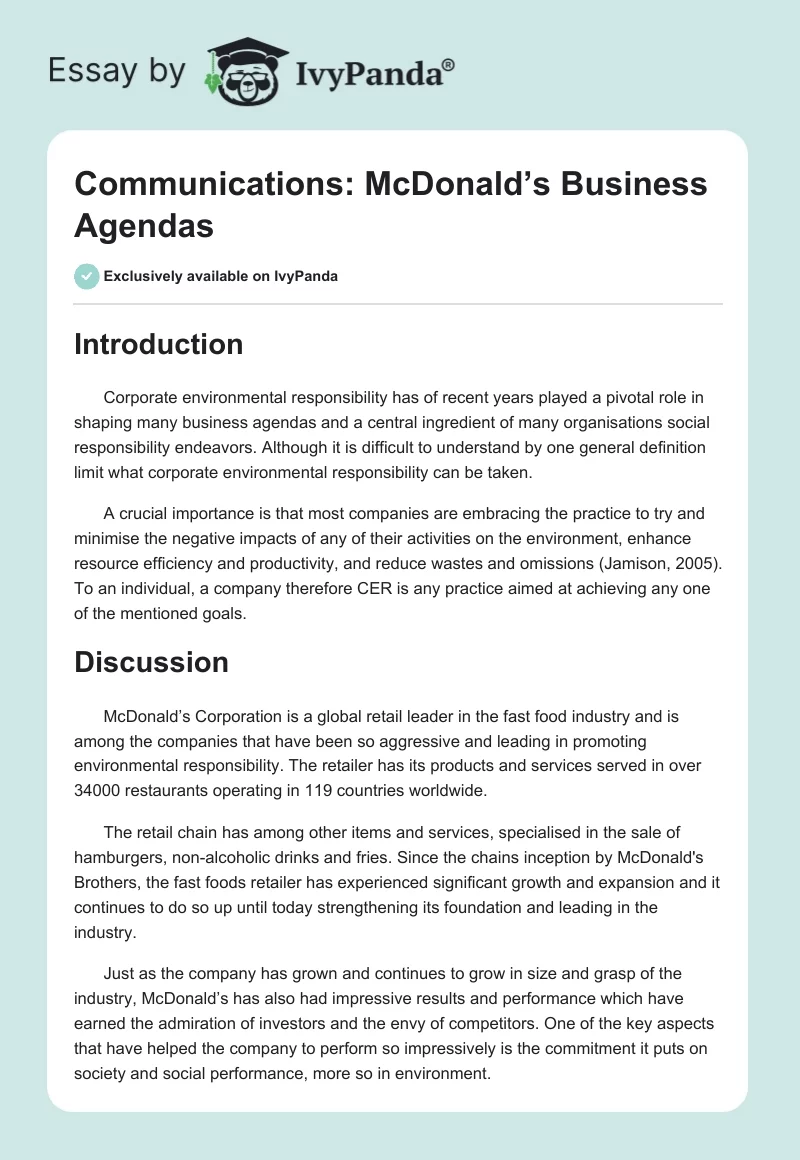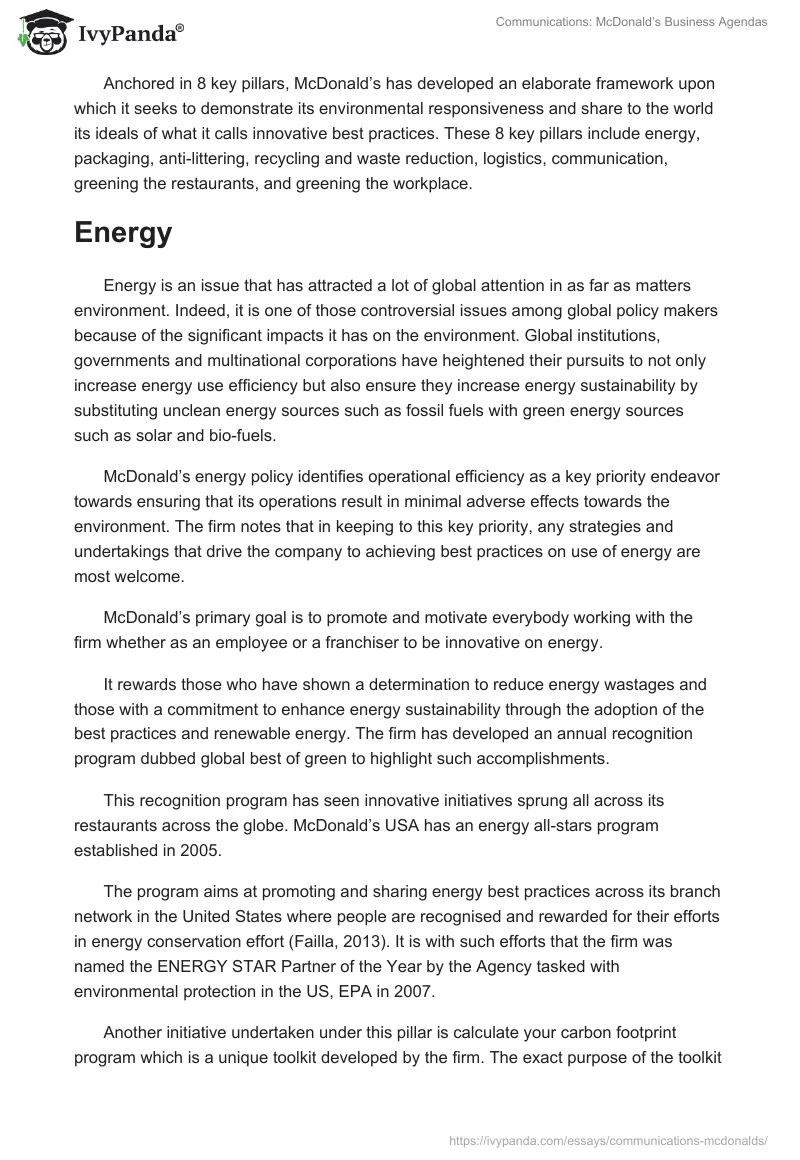Introduction
Corporate environmental responsibility has of recent years played a pivotal role in shaping many business agendas and a central ingredient of many organisations social responsibility endeavors. Although it is difficult to understand by one general definition limit what corporate environmental responsibility can be taken.
A crucial importance is that most companies are embracing the practice to try and minimise the negative impacts of any of their activities on the environment, enhance resource efficiency and productivity, and reduce wastes and omissions (Jamison, 2005). To an individual, a company therefore CER is any practice aimed at achieving any one of the mentioned goals.
Discussion
McDonald’s Corporation is a global retail leader in the fast food industry and is among the companies that have been so aggressive and leading in promoting environmental responsibility. The retailer has its products and services served in over 34000 restaurants operating in 119 countries worldwide.
The retail chain has among other items and services, specialised in the sale of hamburgers, non-alcoholic drinks and fries. Since the chains inception by McDonald’s Brothers, the fast foods retailer has experienced significant growth and expansion and it continues to do so up until today strengthening its foundation and leading in the industry.
Just as the company has grown and continues to grow in size and grasp of the industry, McDonald’s has also had impressive results and performance which have earned the admiration of investors and the envy of competitors. One of the key aspects that have helped the company to perform so impressively is the commitment it puts on society and social performance, more so in environment.
Anchored in 8 key pillars, McDonald’s has developed an elaborate framework upon which it seeks to demonstrate its environmental responsiveness and share to the world its ideals of what it calls innovative best practices. These 8 key pillars include energy, packaging, anti-littering, recycling and waste reduction, logistics, communication, greening the restaurants, and greening the workplace.
Energy
Energy is an issue that has attracted a lot of global attention in as far as matters environment. Indeed, it is one of those controversial issues among global policy makers because of the significant impacts it has on the environment. Global institutions, governments and multinational corporations have heightened their pursuits to not only increase energy use efficiency but also ensure they increase energy sustainability by substituting unclean energy sources such as fossil fuels with green energy sources such as solar and bio-fuels.
McDonald’s energy policy identifies operational efficiency as a key priority endeavor towards ensuring that its operations result in minimal adverse effects towards the environment. The firm notes that in keeping to this key priority, any strategies and undertakings that drive the company to achieving best practices on use of energy are most welcome.
McDonald’s primary goal is to promote and motivate everybody working with the firm whether as an employee or a franchiser to be innovative on energy.
It rewards those who have shown a determination to reduce energy wastages and those with a commitment to enhance energy sustainability through the adoption of the best practices and renewable energy. The firm has developed an annual recognition program dubbed global best of green to highlight such accomplishments.
This recognition program has seen innovative initiatives sprung all across its restaurants across the globe. McDonald’s USA has an energy all-stars program established in 2005.
The program aims at promoting and sharing energy best practices across its branch network in the United States where people are recognised and rewarded for their efforts in energy conservation effort (Failla, 2013). It is with such efforts that the firm was named the ENERGY STAR Partner of the Year by the Agency tasked with environmental protection in the US, EPA in 2007.
Another initiative undertaken under this pillar is calculate your carbon footprint program which is a unique toolkit developed by the firm. The exact purpose of the toolkit is to monitor and measure any efforts and strategies put forth to reduce greenhouse gases.
According to the firm’s 2012 Best of green report, the company has been able to effectively rollout the toolkit usage in its European market, Canada, and it aims at subsequently rolling out the tool kit usage in all other markets. Although the toolkit is a great show of commitment by the firm, one weakness is that the company has not been to profile its savings and or achievements as a result of the toolkit since inception (Rebernak, 2012).
Still on energy, the company has embarked on promotion of the use of energy efficient systems dubbed energy upgrade program. Through this program, the company envisages that energy saving and efficiency play an integral role on energy sustainability. The program which is in line with its core strategy of adopting best practices looks at transforming energy sourcing, behavior and energy management practices.
Finally, under this key pillar, is green energy. The firm has all across its entire global network been able though not 100 percent green introduce substantial green energy initiatives especially solar energy usage where most visible. This is an important step and a considerable one on social performance.
Packaging
While it is universally accepted that packaging plays a critical role in product preservation and marketing, it cannot be lost to point out that it is a growing concern that it considerably contributes to environmental pollution and more so the needless amounts of waste it generates. According to research, packaging waste represents about one third of all of the municipal waste in the United States and this has been growing (Ackerman, 1996).
Perhaps, this is the reason McDonald’s has identified packaging as one of its key pillars towards environmental safeguarding. The firm has been in the forefront towards promoting environmental friendly packaging in all its outlets around the globe. The main goal of the chain is to reduce waste while ensuring that whatever wastes that is generated contributes minimal adverse effects on the environment.
Among the steps taken by the firm which are also engraved in its policy statement on packaging are innovations in packaging design, use of recycled material, and sourcing material only from those sources that show best commitments on sustainability. A lot of strides have been made in shifting from ‘non-friendly’ packaging materials to green packaging.
For instance, McDonald’s has in most of its retail outlets around the globe been able to switch to HAVI global solutions developed packaging solutions.
HAVI has innovative technologies able to turn previously non-decomposable material packages to up to 80 percent recycled material as well in some instances reduce by one-third the amount of material used in packages without any adverse effects on the product.
In addition, the firm has been able, for instance in its Canadian outlets, switch from using white napkins and bags into brown ones which are 85 percent fiber based (McDonalds Corporation, 2013).
Anti-littering
Littering apart from turning our beautiful surroundings into an eye sore has grave consequences on the environment and human health. Littering has the potential to turn a neat and inviting environment into a detestable site within a very short time. Irresponsible littering can lead to some of the garbage ending in water bodies and drainage systems and the effect is better left out of this discussion.
This type of program is more behavioral requiring a lot of sensitisation not only within McDonald’s but also to the entire community including customers. In recognition of this, McDonald’s has through its regional chains been able to carry out wider stakeholder consultations to bring together both organisations and government agencies alike which are conscious of the environment to come up with environmental friendly anti-littering solutions in the communities around the areas it operates in (US EPA, 2010).
Recycling and waste reduction
Any operational undertaking by a company or individual for that matter is bound to produce waste. Waste, as we all understand it, is largely if not exclusively the only thing responsible for environmental pollution. Therefore, any important step taken towards reducing this waste or preventing it from causing harm to the environment can be an important milestone towards safeguarding the environment (Ackerman, 1997).
In McDonald’s recycling and waste reduction are key pillars in its environmental safeguarding program. According to EPA, the benefits that can be reaped from recycling and waste reduction efforts are enormous. They include preventing pollution both direct on disposal and indirectly through manufacture of replacement products, conserve resources and energy and thereby enhance sustainability of future generations, and finally economic sustenance through job creation.
With all these benefits, McDonald’s has initiated programs all across its operations aimed at achieving this key objective. For instance, within the USA alone, McDonald’s estimates savings of 612 trees, significant volumes of water and oil, and savings of 324 cubic yards of landfills through its 36 tons of corrugated cardboards it was able to recycle in 2012.
Similar efforts are being rolled out elsewhere in its areas of operation. Another worth noting undertaking in this pillar is conversion of organic waste into energy such as biogas in Switzerland and into electricity and heat in the United Kingdom (McDonalds Corporation, 2013).
Others
Apart from the four areas discussed above, other efforts and key pillars that McDonald’s has identified as measures to enhance environmental sustainability include logistics, communication, greening the restaurants and greening the workplace. On logistics, the company has put in measures to ensure its logistical operations contribute minimal harm to the environment (McDonalds Corporation, 2013).
Choosing the most environment friendly means as well as those that have put in sustainability considerations such as bio-diesel powered logistical operations is a major yardstick. On communication, the company recognises that information is power. Information has the power to transform bad behaviors that have little or no consideration to environmental sustainability to good ones that are conscious and committed to sustainability.
Indeed, the company has been able to disseminate information through lead by example and such other initiatives to relay information to the community such as its annual publication on sustainability. The company’s overall strategy recognises sustainability and doing business responsibly as important tenets towards fulfilling its mandate. The company has also embarked on green initiatives in its restaurants and workplaces including environmental friendly practices and building (McDonalds Corporation, 2013).
Conclusions and recommendations
In conclusion, McDonald’s has a very well thought out initiative with regards to achieving this noble social performance yardstick on environment. Having a policy and strategies engraved within the company mission indeed affirm to their commitment on safeguarding the environment.
With regards to measurement, monitoring and reporting performance, the company has identified acceptable standards although not in all of its pillars. Looking at the recognitions, the company has received the company’s social performance can be summarised as fairly good.
More however can still be done on improving the gains the company has already achieved. The company needs to work out a consolidated way of reporting in summary targets and performance achievements on each of the identified pillars for the entire organisation.
References
Ackerman, Frank. Why Do We Recycle? Markets, Values, and Public Policy. Washington, DC: Island Press, 1997.
Ackerman, Frank, “Environmental impacts of packaging in the U.S. and Mexico” Scholar, 1996. Web.
Failla, John, “McDonald’s Reports Global Green Practices – Green Retail Decisions,” Green Retail Decisions, 2012. Web.
Jamison, Alison et al, “Defining Corporate Environmental Responsibility: Canadian ENGO Perspectives,” 2005. Web.
McDonalds Corporation, “Best of Green – McDonald’s Best Practices’” 2013. Web.
McDonalds Corporation, “Company Profile: About McDonalds,” 2013. Web.
McDonalds Corporation, “Financial Highlights: About McDonalds,” 2013. Web.
McDonalds Corporation, “Press Releases: About McDonalds,” 2013. Web.
Rebernak, Kathee, “McDonald’s scorecard is commendably concise, but ends up not giving the whole picture.” Ethical Corporation. Web.
US EPA, “Reuse +Recycling=Waste reduction”. Web.


